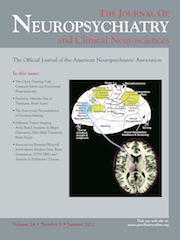Myoclonus Induced by Haloperidol in the Intensive Care Unit
To the Editor: Myoclonus is a movement disorder characterized by sudden, shock-like involuntary movements that can be generated in the neuro-axis including cortex, basal ganglia, brainstem, and spinal cord.1 Variable metabolic disorders, hypoxia, and drugs are among the most common causes of myoclonia, especially in intensive care units.1 Herein, we present a very rare case with myoclonia induced by haloperidol during treatment in an intensive care unit.
Case Report
An 83-year-old man with congestive heart failure was hospitalized because of severe dyspnea and pulmonary edema. His neurological history was unremarkable. Serum biochemistry levels on admission were within normal limits, except for a creatinine level of 1,82 mg/dL. During follow-up, he needed hemodialysis because of his increasing creatinine level (4.49 mg/dl), and antibiotics were given for sepsis. Haloperidol was started at 1 mg tid for delirium symptoms of agitation and time–place disorientation; however, myoclonic jerks in his limbs and trunk were observed after 2 days of haloperidol administration. Meanwhile, all metabolic values were normal except increased creatinine level (4.67 mg/dl). Electroencephalography (EEG) revealed spikes and multiple sharp waves in the posterior regions of hemispheres. His cranial computerized tomography (CT) did not show any focal lesion. Haloperidol was stopped, and clonazepam 0.5 mg bid was given irregularly. His myoclonic jerks subsided during the next 2 days; therefore, clonazepam was discontinued; 4 days later, the patient’s cardiac failure and sepsis worsened and he passed away from cardiac arrest.
Discussion
During hospitalization in the intensive care unit, our patient had multifocal myoclonic jerks, with EEG findings suggesting epileptic myoclonic jerks.2 However, he had no history of epilepsy, and his cranial CT did not show any lesion leading to seizure. Other potentially contributing factors for myoclonic jerks were also considered. Although he had severe cardiac failure accompanied with renal insufficiency, his metabolic values were relatively within normal range. Also, he had no hypoxic episode that might frequently result in multifocal myoclonia.
Interestingly, our patient’s jerks appeared within 2 days of haloperidol administration and stopped after discontinuation. We consider that effect of clonazepam on supression of jerks could be negligible with these minute amounts. Furthermore, antipsychotics can cause EEG abnormality, and especially atypical ones can induce dose-dependent myoclonic jerks.3,4 Because of that close temporal relationship between myoclonic jerks and haloperidol administration, a rare phenomenon of haloperidol-induced myoclonus5 has been suggested.
The pro-convulsant properties of conventional antipsychotics range between 0.5% and 1.2% among nonepileptic patients. Haloperidol has a lower seizure risk,3 but the risk is higher in patients with abnormal EEG, history of epilepsy, and central nervous system disorder. The pathophysiology of myoclonic jerks is not clear, but interactions of several neurotransmitters, such as serotonin and dopamine has been suggested.1 Blockade of dopamine receptors at the nigrostriatal pathways by haloperidol may result in myoclonia, similar to other acute and chronic movement disorders. However, all patients taking haloperidol do not experience these movement and seizure disorders, so susceptibility of some patients with focal or global CNS disorder and chronic metabolic problems must be considered.
Haloperidol is frequently prescribed in patients with delirium. We should be apprised of its rare side effect, the appearance of myoclonic jerks. Overtreatment with antiepileptics can be prevented in these patients who are taking multiple drugs in the intensive care unit.
1 : Clinical neurophysiology of myoclonus, in Psychogenic Movement Disorders:Neurology and Neuropsychiatry. Edited by Hallett MFahn SJankovic J. Philadelphia, Lippincott Williams & Wilkins, 2006, pp 262–264Google Scholar
2 : What’s shaking in the ICU? the differential diagnosis of seizures in the intensive care setting. Epilepsia 2010; 51:2338–2340Crossref, Medline, Google Scholar
3 : Adverse effects of antipsychotic drugs. Int Clin Psychopharmacol 1995; 9(Suppl 5):21–27Crossref, Medline, Google Scholar
4 : Olanzapine-induced myoclonic status. Clin Neuropharmacol 2005; 28:145–147Crossref, Medline, Google Scholar
5 : Multifocal myoclonus induced by haloperidol. Neurol Sci 2009; 30:385–386Crossref, Medline, Google Scholar



